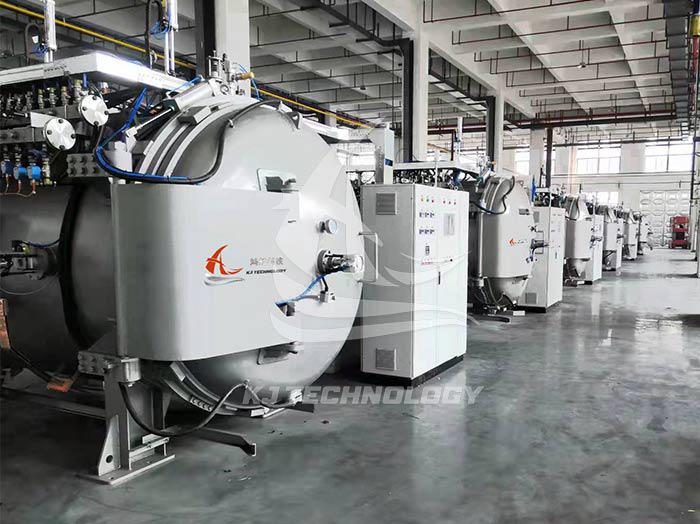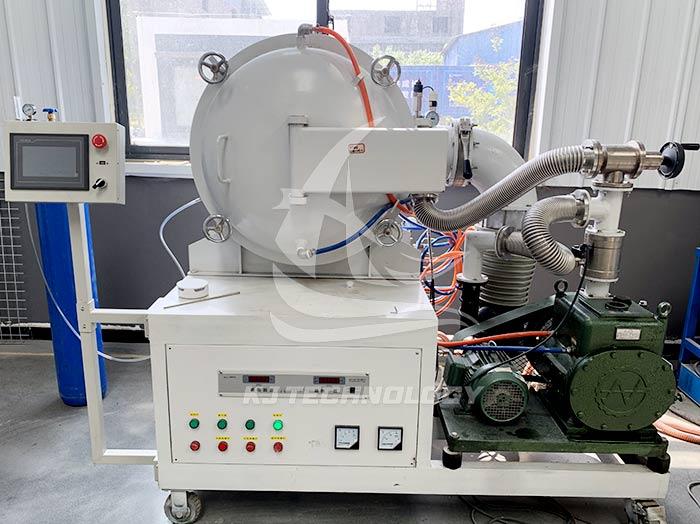Precautions for using a vertical graphite carbon tube vacuum furnace
 10-17-2025 Author: KJ technology
10-17-2025 Author: KJ technology
When using a vertical graphite carbon tube vacuum furnace, strict control should be taken from five aspects: operation specifications, safety protection, equipment maintenance, environmental control, and emergency response. The following are specific precautions:
1. Operating standards
Parameter Settings
Temperature control: Set the heating rate according to the material characteristics (such as ceramic sintering requiring slow heating to 1200-1600 ℃) to avoid cracking caused by thermal stress.
Vacuum degree adjustment: Before sintering, the vacuum degree inside the furnace needs to be pumped to the target value to prevent material oxidation; Accurate control of gas flow is required during inert atmosphere sintering.
Insulation time: Set the insulation time according to the thickness and density of the material (such as 2-4 hours for hard alloys) to ensure uniform performance of the sintered body.
Loading and unloading
Uniform distribution: Materials should be evenly placed in the furnace to avoid local overheating or uneven temperature.
Handle with care: Use specialized tools (such as graphite fixtures) for loading and unloading materials to prevent collision damage to the furnace body or heating elements.
Preheating treatment: Materials containing volatile components (such as certain polymers) need to be dried in advance to reduce gas release during the sintering process.
program control
Segmented heating: Adopting a multi-stage heating program (such as room temperature → 300 ℃ insulation for 1 hour → 800 ℃ insulation for 2 hours → target temperature) to meet the phase transition requirements of different materials.
Data recording: Record temperature, vacuum degree, gas flow rate and other parameters throughout the process for easy traceability and analysis.
2. Security protection
high-temperature protection
Insulation measures: Wear high-temperature gloves, protective face shields, and insulation clothing during operation to avoid direct contact with the surface of the furnace body (temperature can reach 2300 ℃ or above).
Warning signs: Set up high temperature warning signs around the furnace body and prohibit unrelated personnel from approaching.
Vacuum safety
Pressure monitoring: Real time monitoring of furnace pressure to prevent sudden pressure rise caused by vacuum pump failure.
Pressure relief device: Ensure the normal operation of the pressure relief valve and safety valve to avoid damage to the furnace due to overpressure.
Electrical safety
Grounding protection: Check if the equipment is properly grounded to prevent electric leakage and shock.
Insulation testing: Regularly test the insulation performance of heating elements and power lines to ensure no damage or aging.
Gas safety
Ventilation system: The operating room should be equipped with a forced exhaust device to prevent inert gas (such as argon) leakage and suffocation.
Gas purity: Use high-purity gas (such as 99.999% argon) to avoid impurities affecting sintering quality.
3. Equipment maintenance
routine inspection
Heating element: Check the appearance of graphite carbon tubes weekly for cracks, oxidation, or detachment.
Vacuum system: Check the oil level and quality of the vacuum pump daily, and replace contaminated oil in a timely manner.
Sealing components: Check the sealing rings of the furnace door and observation window every month for any signs of aging or deformation.
regular maintenance
Cleaning the furnace: After each batch of sintering, wipe the inner wall of the furnace with a dust-free cloth to remove any residue.
Calibration instruments: Calibrate temperature sensors and vacuum gauges quarterly to ensure measurement accuracy.
Lubricating components: Apply high-temperature lubricating grease to the lifting mechanism and transmission components to reduce wear.
Professional Repair
Fault handling: If abnormal heating or vacuum leakage is found, immediately stop the machine and contact professional personnel for repair.
Spare parts reserve: Reserve commonly used spare parts (such as graphite carbon tubes, sealing rings) to shorten maintenance cycles.
4. Environmental control
Temperature and humidity
Operating room temperature: Control between 5-35 ℃ to avoid extreme temperatures affecting equipment performance.
Humidity control: Relative humidity ≤ 70% to prevent electrical components from being affected by moisture and short circuiting.
cleanliness
Dust prevention measures: Dust resistant carpets are laid on the floor of the operating room, and dust covers are installed around the equipment.
Regular cleaning: Clean the operating room daily to reduce dust accumulation.
Ventilation requirements
Exhaust system: Ensure that the exhaust volume is ≥ 300m ³/h and promptly discharge trace gases generated during the sintering process.
5. Emergency response
Temperature out of control
Immediate shutdown: Press the emergency stop button to cut off the power supply.
Natural cooling: Open the furnace door to naturally cool down, and do not use water or force air cooling.
Vacuum leakage
Turn off the gas source: Quickly close the intake valve to prevent continuous gas leakage.
Personnel evacuation: If the leaked gas is toxic or flammable, immediately evacuate personnel and activate emergency plans.
electrical fault
Power off inspection: After cutting off the power, check whether the circuit and switch are short circuited or burned out.
Professional maintenance: Contact an electrician for troubleshooting and prohibit non professionals from operating.








